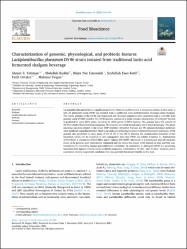| dc.contributor.author | Yetiman, Ahmet E. | |
| dc.contributor.author | Keskin, Abdullah | |
| dc.contributor.author | Darendeli, Busra Nur | |
| dc.contributor.author | Kotil, Seyfullah Enes | |
| dc.contributor.author | Ortakci, Fatih | |
| dc.contributor.author | Dogan, Mahmut | |
| dc.date.accessioned | 2023-04-05T07:15:53Z | |
| dc.date.available | 2023-04-05T07:15:53Z | |
| dc.date.issued | 2022 | en_US |
| dc.identifier.issn | 2212-4292 | |
| dc.identifier.issn | 2212-4306 | |
| dc.identifier.other | WOS:000772171300006 | |
| dc.identifier.uri | https://doi.org/10.1016/j.fbio.2021.101499 | |
| dc.identifier.uri | https://hdl.handle.net/20.500.12573/1561 | |
| dc.description.abstract | Lactiplantibacillus plantarum is a significant probiotic where it could be found in ubiquitous niches. In this study, a
new Lb. plantarum strain DY46 was isolated from a traditional lactic-acid-fermented beverage called shalgam.
The whole genome of the DY46 was sequenced and obtained sequences were assembled into a 3.32 Mb draft
genome using PATRIC (3.6.8.). The DY46 genome consists of a single circular chromosome of 3,332,827 bp that
is predicted to carry 3219 genes, including 61 tRNA genes, 2 rRNA operons. The genome has a GC content of
44.3% includes 98 predicted pseudogenes, 25 complete or partial transposases and 3 intact prophages. The genes
encoding enzymes related in the intact EMP (Embden–Meyerhof–Parnas) and PK (phosphoketolase) pathways
were predicted using BlastKOALA which is an indicator of having facultative heterofermentative pathways. DY46
genome also predicted to carry genes of Pln E, Pln F and Pln K showing the antimicrobial potential of this
bacterium which can be linked to in vitro antagonism tests that DY46 can inhibit S.enterica sv. Typhimurium
ATCC14028, K. pneumonie ATCC13883, and P. vulgaris ATCC8427. Moreover, it is determined that all resistome
found in its genome were intrinsically originated and the strain was found to be tolerant to acid and bile concentrations by mimicking human gastrointestinal conditions. In conclusion, L. plantarum DY46 is a promising
bacterium that appears to have certain probiotic properties, confirmed by “in vitro” and “in silico” analyses, and is
a potential dietary supplement candidate that may provide functional benefits to the host. | en_US |
| dc.description.sponsorship | Erciyes University FKB-2020-10551 | en_US |
| dc.language.iso | eng | en_US |
| dc.publisher | ELSEVIER | en_US |
| dc.relation.isversionof | 10.1016/j.fbio.2021.101499 | en_US |
| dc.rights | info:eu-repo/semantics/openAccess | en_US |
| dc.subject | Shalgam | en_US |
| dc.subject | Lactiplantibacillus plantarum | en_US |
| dc.subject | Probiotic | en_US |
| dc.subject | Carbohydrate fermentation patterns | en_US |
| dc.subject | Genome | en_US |
| dc.title | Characterization of genomic, physiological, and probiotic features Lactiplantibacillus plantarum DY46 strain isolated from traditional lactic acid fermented shalgam beverage | en_US |
| dc.type | article | en_US |
| dc.contributor.department | AGÜ, Yaşam ve Doğa Bilimleri Fakültesi, Biyomühendislik Bölümü | en_US |
| dc.contributor.authorID | 0000-0001-5340-5106 | en_US |
| dc.contributor.authorID | 0000-0003-1319-0854 | en_US |
| dc.contributor.institutionauthor | Keskin, Abdullah | |
| dc.contributor.institutionauthor | Ortakci, Fatih | |
| dc.identifier.volume | 46 | en_US |
| dc.identifier.issue | 101499 | en_US |
| dc.identifier.startpage | 1 | en_US |
| dc.identifier.endpage | 13 | en_US |
| dc.relation.journal | FOOD BIOSCIENCE | en_US |
| dc.relation.publicationcategory | Makale - Uluslararası Hakemli Dergi - Kurum Öğretim Elemanı | en_US |


















